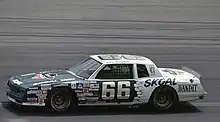Generation 3 (NASCAR)
The Generation 3 refers to the generation of stock cars used in NASCAR from 1981 to 1991, and it was used in the Busch Series until 1993. In this generation, NASCAR downsized the cars to better resemble cars on the showroom floor (with wheelbase at 110 inches), and body panels were still purchased through the manufacturers.[1]
 Phil Parsons' No. 66 Chevrolet Monte Carlo in 1984 | |
| Constructor | |
|---|---|
| Predecessor | Generation 2 |
| Successor | Generation 4 |
| Technical specifications | |
| Wheelbase | 110 inches |
| Engine | 90° pushrod V-8 358 cubic inches (5,870 cc) |
| Fuel | Unocal 76 (1989-1992) |
| Tires | Goodyear |
| Competition history | |
| Debut | February 15, 1981 (1981 Daytona 500) |
| Last event | November 17, 1991 (1991 Hardees 500) |
History
Cup Series
The Generation 3 era began in 1981[1] and featured bigger spoilers, and streamlined designs[2] that barely resembled their showroom counterparts.[2] The wheelbase was reduced to 110 inches in response to the demand of the production car market that the time, making the cars smaller than the previous 2 generations.[2]
These were the cars that necessitated restrictor plates at Daytona and Talladega. In 1987 at Talladega, Bill Elliott set what remains the NASCAR qualifying record of 212.809 mph (342.483 km/h). But soon into the race, Bobby Allison's car went airborne and nearly went into the main grandstands, and that was the last unrestricted race on either of the two giant tracks. NASCAR mandated smaller carburetors for the rest of that season, and in 1988 required the restrictor plates.[3]
The Generation 3 cars were used until 1991. It was the last generation without roof flaps (mandated in 1994). It was succeeded by the Generation 4 cars in 1992. In that same year, the Gen 3 car was still used in the Busch Series, until the series adopted their Generation 4 car in 1994.
Xfinity Series
In 1982, NASCAR Xfinity Series competitors began looking at alternatives from the 5-litre based (311 cu in (5 L) engines, as in short track racing there was a push for six-cylinder engines in short track racing to save on costs, with some series allowing weight breaks. One popular idea was to use 231–275 cu in (4–5 L) six-cylinder engines; instead of Cup Series' 358 cu in (5.9 L) V-8s.[4][5][6] In 1989, NASCAR changed rules requiring cars to use current body styles, similar to the Cup cars. However, the cars still used V6 engines. The cars gradually became similar to Cup cars.
Models
General Motors
.jpg.webp)
- Buick Regal: 1981–1985, 1988–1991
- Buick LeSabre: 1986–1987
- Chevrolet Lumina: 1989–1991
- Chevrolet Monte Carlo: 1981–1989
- Oldsmobile Cutlass: 1981–1991
- Oldsmobile Delta 88: 1986–1987
- Pontiac Grand Prix: 1981-1991
- Pontiac LeMans: 1982-1983
Ford Motor Company
- Ford Thunderbird: 1981–1991
Chrysler Corporation
- Chrysler Cordoba: 1980-?
- Dodge Mirada: 1981-1986
- Imperial: 1981-1986
See also
References
- "The evolution of NASCAR Cup Series cars". NASCAR.com. July 28, 2021.
{{cite web}}: CS1 maint: url-status (link) - Weaver, Matt (May 6, 2021). "NASCAR Generations". Autoweek.com.
{{cite web}}: CS1 maint: url-status (link) - Hinton, Ed (January 15, 2013). "Six generations of NASCAR cars". ESPN.com.
{{cite web}}: CS1 maint: url-status (link) - "Turn Back The Clock: 1995 NASCAR Season, The Crossroads". frontstretch.com. 7 April 2020. Retrieved October 13, 2021.
- "1994 Chevy 90 deg V6 Race Engine Spec Sheet". oval.race-cars.com. Retrieved October 13, 2021.
- "2 Less = More, Stage II V-6".
External links
| Wikimedia Commons has media related to Generation 3 NASCAR automobiles. |